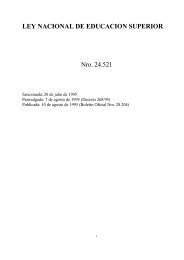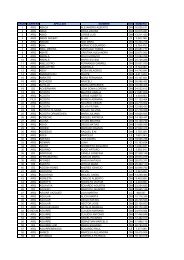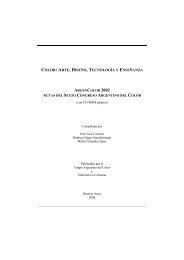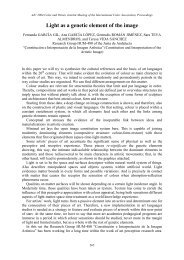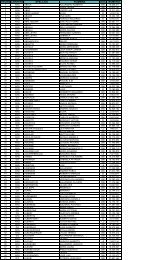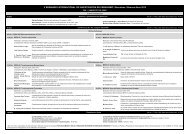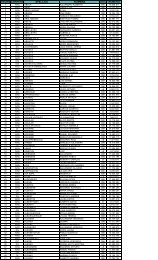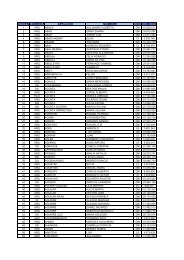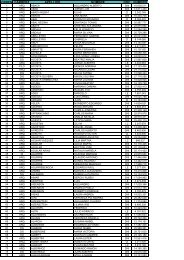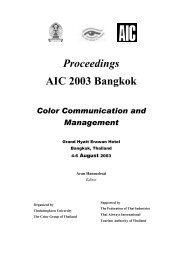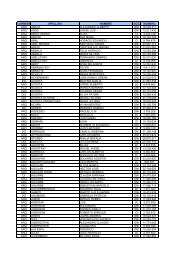Four soil color charts compared in CIELAB color space
Four soil color charts compared in CIELAB color space
Four soil color charts compared in CIELAB color space
Create successful ePaper yourself
Turn your PDF publications into a flip-book with our unique Google optimized e-Paper software.
AIC 2004 Color and Pa<strong>in</strong>ts, Interim Meet<strong>in</strong>g of the International Color Association, Proceed<strong>in</strong>gsOur goal <strong>in</strong> this study is to evaluate the regularity <strong>in</strong> <strong>CIELAB</strong> <strong>color</strong> <strong>space</strong> of the chips fromfour standard <strong>soil</strong> <strong>color</strong> <strong>charts</strong> from two different manufacturers, hav<strong>in</strong>g different use degrees.2.1 Soil Color Charts2. MATERIAL AND METHODSTwo standard American editions of the Munsell Soil Color Charts (Munsell Color Co. 1975,2000) and two standard Japanese editions of the Revised Standard Soil Color Charts (FujiharaIndustry Co. 1970, 2001) were analyzed spectrophotometrically. The American <strong>charts</strong> of 1975(USA1975) and 2000 (USA2000) have 180 and 238 chips, respectively, arranged on sevenhue <strong>charts</strong>: 10R, 2.5YR, 5YR, 7.5YR, 10YR, 2.5Y, and 5Y. Both the Japanese <strong>charts</strong> of 1970(JAPAN1970) and 2001 (JAPAN2001) have 258 chips, <strong>in</strong>clud<strong>in</strong>g an additional hue chart(7.5R). The USA2000 and JAPAN2001 <strong>charts</strong> were completely new, whereas JAPAN1970and USA1975 had been previously used for <strong>soil</strong> <strong>color</strong> measurements <strong>in</strong> the field andlaboratory. Before spectrophotometric <strong>color</strong> measurements, the chips of JAPAN1970 andUSA1975 were cleaned by wip<strong>in</strong>g off the dirt lightly with a clean wet cloth.2.2 Color measurementsColor measurements of all chips were performed us<strong>in</strong>g a M<strong>in</strong>olta CM-2600dspectrophotometer, operat<strong>in</strong>g with specular component excluded, and a bandwidth of 10 nm.N<strong>in</strong>e measurements (3 zones × 3 replications) were made for each <strong>color</strong> chip, and the averageresult was adopted for further computations. The D65 illum<strong>in</strong>ant and CIE 1964Supplementary Standard Observer were assumed for the calculation of <strong>color</strong>imetric data <strong>in</strong><strong>CIELAB</strong> system (CIE 1986). The repeatability (standard deviation of ten successivemeasurements) of our <strong>in</strong>strument for the <strong>CIELAB</strong> coord<strong>in</strong>ates was lower than 0.048 units.Lightness, chroma and hue-differences between neighbor<strong>in</strong>g chips with<strong>in</strong> each <strong>color</strong> chartwere analyzed from ∆L*, ∆C*, and ∆H*, the later us<strong>in</strong>g the Sève’s equation (Sève 1991).3. RESULTS AND DISCUSSIONWe plotted <strong>in</strong> <strong>CIELAB</strong> the Munsell loci of constant hue and chroma (Figure 1). Each po<strong>in</strong>t onthe a*b* plane was the average of the chromatic coord<strong>in</strong>ates measured for the <strong>color</strong> chips withthe same Munsell hue and chroma notations. So, these loci refer to the average Munsell valueof the <strong>charts</strong>. Accord<strong>in</strong>g to Berns (2000), <strong>in</strong> a perfect match between the Munsell variablesand <strong>CIELAB</strong>, these loci of constant hue and chroma would be a symmetrical and circular‘spider-web’ plot. The chart USA2000 approaches this condition rather well (Figure 1a). Thehue l<strong>in</strong>es, which jo<strong>in</strong> dots of constant Munsell hue, are nearly straight and evenly <strong>space</strong>d. Thechroma contours, which jo<strong>in</strong> dots of constant Munsell chroma, are nearly circular on the a*b*diagram.There was very little difference <strong>in</strong> how well the <strong>color</strong> chips were visually <strong>space</strong>d <strong>in</strong> hue <strong>in</strong>USA2000 (Figure 1a) and JAPAN2001 (Figure 1b). The <strong>CIELAB</strong> hue-differences (∆H*)between neighbor<strong>in</strong>g chips at chroma /1, /2, /3, /4, /6, and /8 were 0.93, 1.68, 2.44, 3.05, 4.42,and 5.72 <strong>CIELAB</strong> units, respectively, <strong>in</strong> USA2000, and 0.88, 1.68, 2.40, 3.15, 4.51, and 5.72<strong>CIELAB</strong> units <strong>in</strong> JAPAN2001. However, the values of ∆L* and ∆C* (with some exceptionsat 2.5Y) were greater <strong>in</strong> USA2000 than <strong>in</strong> JAPAN2001 (Table 1). This means that the152
AIC 2004 Color and Pa<strong>in</strong>ts, Interim Meet<strong>in</strong>g of the International Color Association, Proceed<strong>in</strong>gslightness and chroma distances between new <strong>color</strong> chips depended on the manufacturer. Onthe average, <strong>in</strong> the Japanese <strong>charts</strong>, ∆L* values were 8.98 and ∆C* 5.36 <strong>CIELAB</strong> units, whilethe average values <strong>in</strong> the American <strong>charts</strong> were 9.90 and 5.86 <strong>CIELAB</strong> units, respectively.b*6050403020100-10Hue l<strong>in</strong>esChroma contours-10 0 10 20 30 40 50 60a*(a)Color chips with the same MunsellHue and Chroma <strong>in</strong> USA2000Figure 1. Loci of constant Munsell hue and chroma for American (a) and Japanese <strong>soil</strong>-<strong>color</strong><strong>charts</strong> (b) plotted <strong>in</strong> <strong>CIELAB</strong>.As illustrated <strong>in</strong> Figure 1b, the old <strong>charts</strong> have greater irregularities <strong>in</strong> the hue and chromaspac<strong>in</strong>g. With respect to the new <strong>charts</strong> (JAPAN2001), the l<strong>in</strong>es appeared deformed <strong>in</strong> the old<strong>charts</strong> (JAPAN1970). For the old <strong>charts</strong>, Munsell hue l<strong>in</strong>es are unevenly <strong>space</strong>d and Munsellchroma contours have ups and downs. The chroma contours <strong>in</strong> JAPAN1970 are below thoseof JAPAN2001, and the hue l<strong>in</strong>es <strong>in</strong> JAPAN1970 are on the right or left of the hue l<strong>in</strong>es ofJAPAN2001. More specifically, it seems that yellow <strong>charts</strong> such as 5Y, 2.5Y or 10YRreddened, while red <strong>charts</strong> as 7.5R or 10R underwent a certa<strong>in</strong> yellow<strong>in</strong>g, and all <strong>charts</strong> faded<strong>in</strong> chroma as a consequence of the field and laboratory use.Table 1. Average <strong>CIELAB</strong> lightness (∆L*) and chroma (∆C*) differences for one step ofMunsell value and chroma, respectively, <strong>in</strong> hue <strong>charts</strong> of different editions.Charts 7.5R 10R 2.5YR 5YR 7.5YR 10YR 2.5Y 5YJAPAN1970 ∆L* 7.45 7.19 7.07 7.02 7.62 7.41 7.57 7.73JAPAN1970 ∆C* 4.28 4.58 4.30 4.11 4.23 4.94 5.10 5.66USA1975 ∆L* 9.51 8.35 9.13 8.98 9.45 9.37 9.41USA1975 ∆C* 4.89 4.90 5.43 5.31 5.80 6.31 6.14USA2000 ∆L* 9.93 10.15 9.83 9.88 10.01 9.95 9.55USA2000 ∆C* 5.27 5.46 5.80 5.85 6.33 5.95 6.33JAPAN2001 ∆L* 8.64 8.95 8.82 8.90 9.20 9.06 9.12 9.14JAPAN2001 ∆C* 4.60 4.78 4.90 5.09 5.49 5.63 6.09 6.33Color fad<strong>in</strong>g over time seems to have homogenized the <strong>color</strong> gamut represented by theJapanese <strong>charts</strong>, reduc<strong>in</strong>g the hue, lightness, and chroma distances between neighbor<strong>in</strong>gchips. With respect to the new <strong>charts</strong>, hue differences (∆H*) decreased <strong>in</strong> old <strong>charts</strong> between0.24 (at chroma /1) and 0.80 (at chroma /6) <strong>CIELAB</strong> units, with a mean reduction of 21%. Onthe average, lightness and chroma distances (∆L* and ∆C* <strong>in</strong> Table 1) also change from 8.98b*6050403020100-10Hue 5YHue 2.5YHue 10YRHue 7.5YRHue 5YRHue 2.5YRChroma /3Chroma /2Chroma /1Chroma /8Chroma /6Chroma /4-10 0 10 20 30 40 50 60a*Hue 10RHue 7.5R(b)JAPAN2001JAPAN1970153
AIC 2004 Color and Pa<strong>in</strong>ts, Interim Meet<strong>in</strong>g of the International Color Association, Proceed<strong>in</strong>gsand 5.36 <strong>CIELAB</strong> units <strong>in</strong> JAPAN2001 to 7.38 and 4.65, respectively, <strong>in</strong> JAPAN1970. This<strong>in</strong>dicates a reduction of lightness distance by 18% and chroma distance by 13%.Although we do not know the specific causes, <strong>color</strong> fad<strong>in</strong>g <strong>in</strong> American used <strong>charts</strong> wasless pronounced. The average values <strong>in</strong> USA2000 were 9.90 for ∆L* and 5.86 for ∆C*,whereas the average values <strong>in</strong> USA1975 were 9.17 for ∆L* and 5.54 for ∆C*. A reduction ofonly 0.73 units (7%) for ∆L*, and 0.32 units (5%) for ∆C* occurred <strong>in</strong> USA1975.4. CONCLUSIONSThis study shows that the steps between <strong>color</strong> chips of standard <strong>soil</strong> <strong>color</strong> <strong>charts</strong> havedifferent size depend<strong>in</strong>g on their manufacturer and degree of use. For new <strong>charts</strong>, averagelightness and chroma distances between nearest neighbor<strong>in</strong>g chips <strong>in</strong> American <strong>charts</strong> aregreater than <strong>in</strong> Japanese <strong>charts</strong> by 0.92 and 0.50 <strong>CIELAB</strong> units, respectively. Compar<strong>in</strong>g theaverage step of old and new <strong>charts</strong>, lower hue (0.80 to 0.24 <strong>CIELAB</strong> units), lightness (1.60 to0.73 <strong>CIELAB</strong> units), and chroma (0.71 to 0.31 <strong>CIELAB</strong> units) differences were found.We believe that the orig<strong>in</strong>al quality of pr<strong>in</strong>t<strong>in</strong>g and the <strong>color</strong> fad<strong>in</strong>g over time lead torelevant <strong>color</strong> changes <strong>in</strong> standard <strong>soil</strong> <strong>color</strong> <strong>charts</strong>.ACKNOWLEDGMENTSResearch Projects CGL2004-02282/BTE and FIS2004-05537, M<strong>in</strong>isterio de Educación yCiencia (Spa<strong>in</strong>) and FEDER. Acción Coord<strong>in</strong>ada BOJA N° 17 de 27.01.2004.REFERENCESBerns, R. S. 2000. Billmeyer and Saltzman’s Pr<strong>in</strong>ciples of <strong>color</strong> technology. New York: John Wileyand Sons.Bigham, J. M., and E. J. Ciolkosz. 1993. Soil <strong>color</strong>. Madison: Soil Science Society of America.CIE. 1986. Colorimetry, Publication 15.2. Vienna: Commission Internationale de l’Éclairage.Dobos, R. R., E. J. Ciolkosz, and W. J. Waltman. 1990. The effect of organic carbon, temperature,time, and redox conditions on <strong>soil</strong> <strong>color</strong>. Soil Science 150: 506-512.FAO. 1998. World reference base for <strong>soil</strong> resources, World Soil Resources Reports 84. Rome: Foodand Agriculture Organization of the United Nations.Fujihara Industry Co. 1970. Revised standard <strong>soil</strong> <strong>color</strong> <strong>charts</strong>. Tokyo: Fujihara Industry Company.——. 2001. Revised standard <strong>soil</strong> <strong>color</strong> <strong>charts</strong>. Tokyo: Fujihara Industry Company.Melville, M. D., and G. Atk<strong>in</strong>son. 1985. Soil <strong>color</strong>: Its measurements and its designation <strong>in</strong> models ofuniform <strong>color</strong> <strong>space</strong>. Journal of <strong>soil</strong> Science 36: 495-512.Munsell Color Co. 1975. Munsell <strong>soil</strong> <strong>color</strong> <strong>charts</strong>. Baltimore: Munsell Color Company.——. 2000. Munsell <strong>soil</strong> <strong>color</strong> <strong>charts</strong>. Baltimore: Munsell Color Company.Sève, R. 1991. New formula for the computation of CIE 1976 hue difference. Color Research andApplication 16: 217-218.Soil Survey Staff. 1993. Soil survey manual, Handbook 18. Wash<strong>in</strong>gton: US Government Pr<strong>in</strong>t<strong>in</strong>gOffice.——. 1999. Soil taxonomy: A basic system of <strong>soil</strong> classification for mak<strong>in</strong>g and <strong>in</strong>terpret<strong>in</strong>g <strong>soil</strong>surveys, Handbook 436. Wash<strong>in</strong>gton: US Government Pr<strong>in</strong>t<strong>in</strong>g Office.Address: Manuel Sánchez Marañón, Departamento de EdafologíaFacultad de Ciencias, Universidad de Granada, 18071 Granada, Spa<strong>in</strong>E-mails:154



